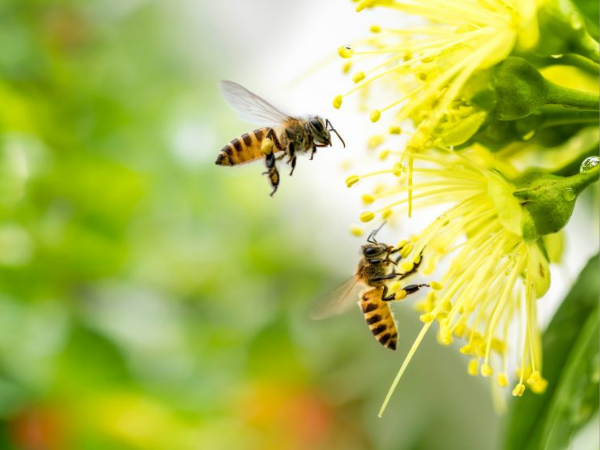Kickstarter Update
As a part of our latest Kickstarter, The Carnivore Bar is coming out with a new bar made with raw honey! To celebrate this new option in the Carnivore Bar line up, we’re going to explore what pollinators are up against and what we can do about it. Keeping with the Carnivore Bar tradition, the ingredients in the new bar option remain clean, real, and nutrient-dense: raw honey, grass-finished beef, tallow, and Redmond Real Salt. Like tallow, honey has the ability to last on the shelf for an incredibly long time. Its natural antibacterial properties and lack of water give it a near eternal shelf life. This precious and impressive byproduct of the bee life cycle pairs well with beef in more ways than just snack form.
Bees & Pollinators

Bees and other pollinators are some of earth’s most important animals. Pollinators are needed for the life cycle of 90% of flowering plants and one third of all crops grown. We have bees to thank for nearly every food available to us. Domestic honey bees pollinate an estimated $10 billion worth of crops each year and wild bees are essential for supporting entire ecosystems. Humans have enjoyed honey and all of its uses for over 9,000 years -- nearly as long as we’ve kept domesticated cattle.
Modern agriculture has not done any kindness to the very things it depends on. In fact, modern large scale agricultural practices like planting only one crop for miles on end -- known as monoculture cropping – and heavy pesticide and herbicide use are leading contributors to a more than 50% decline in pollinator numbers since 1947.
Point of interest: Check out where we source our beef from.
Digging into pollinator numbers is a grim endeavor that doesn’t have to end on an alarmist note. Although modern agriculture is largely responsible for pollinator population declines, it also offers solutions to the problem. There are many different avenues for agriculture to support rather hurt pollinators. Regenerative farming practices are the most talked about in terms of growing food in ways that add to the environment rather than extract from it. Regenerative farming is difficult to accomplish on a large scale and we can’t expect all farming to transition into soil building, ecologically sound practices immediately. Raising cattle and other ruminant livestock on the landscape is a great start for growing food within natural systems and a promising one for long term food sustainability.
Cattle and pollinators rely on the very same habitat: Grasslands. Cattle and bees sharing the landscape does not mean they are at odds with each other—in fact, they both rely on each other. As I’ve outlined in previous articles, grassland ecosystems are critical for growing beef and other ruminant livestock. Cattle require grassland systems for their life cycle no matter how they’re finished.

The nutrient density of beef largely depends on the biodiversity of the land that the cattle forage on. Biodiverse perennial grasslands require periodic grazing and pollination in order to maintain a healthy ecosystem. Properly managed ruminants are the key not only to the prairie, but also to the best quality meat. The bulk of the forage cattle need does not directly rely on pollinators flying from plant to plant to reproduce. The grassland system cattle need, however, is made up of an intricate web of different species that rely on pollinators like native bees, moths, and butterflies to grow. Although cattle don’t rely on the flowering plants that support pollinators, growing beef would be incredibly difficult if not impossible without pollinators supporting the whole grassland system. Grassland ecosystems as a whole rely on pollinators and pollinators rely on large tracts of grasslands. As long as cattle are around, pollinators will have large landscapes to live on.
This is not to say that cattle are the end all be all answer to our problems on the pollinator front. Keeping cattle on the landscape is becoming a bigger challenge every year as more native prairie is lost to land conversion. In 2019 alone, 2 million acres of grassland habitat was converted to industrial farmland and urban development in the US.
Beef & Bees In Harmony

The role of beef in supporting pollinators and pollinator habitat is enormous. This claim isn’t just a way for a rancher like myself to advocate for her livelihood. Organizations like World Wildlife Fund, the Audubon Society, Patagonia, and more have started acknowledging and supporting ranchers stewarding native grasslands. Large organizations like the ones listed above have historically been at odds with the agriculture industry until they began conducting their own surveys and wildlife population studies on working lands. Their findings supported what long time land stewards already knew: healthy land grows healthy cattle.
When reading the alarming statistics of pollinator and grassland loss, it’s important to note that nature is incredibly resilient. We are not past the point of no return yet and we have real solutions at our fingertips. If we are intentional about using these numbers to make well informed decisions as consumers, we can directly support what we want to see happen on the land. Agricultural writer and philosopher Wendell Berry said it best, as he often does, in his book of essays called The Art of Commonplace: “…the care of the earth is our most ancient and most worthy and, after all, our most pleasing responsibility. To cherish what remains of it, and to foster its renewal, is our only legitimate hope.” As long as there is a demand for quality beef, there will be livestock producers fostering the renewal of the land we and the pollinators both rely on.
Shop The Carnivore Bar (Honey Option Now Available)



Leave a comment: